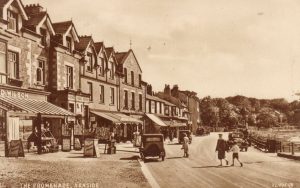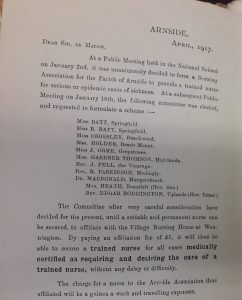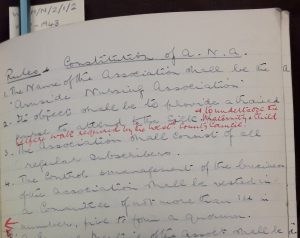| Janet Hargreaves, University of Huddersfield (Retired) | The UKAHN Bulletin |
| Volume 10 (1) 2022 | |
Having the good fortune to retire to the village of Arnside, my natural inclination was to join the local history group (Arnside Archive), to find out what had already been written about nursing here. The answer was nothing; so, when the British Newspaper Archive revealed that there had been a thriving Nursing Association in Arnside in the 1930s, this seemed like a good place to start exploring.
Arnside is a small village in South Cumbria, one of several villages in an Area of Outstanding Natural Beauty[1] on the Kent estuary as it enters Morecambe Bay. (Fig 1) A combination of limestone outcrops, and low-lying salt marshes make its landscape unique, but pose a challenge for transport, civil engineering and accessibility. During the nineteenth century it grew incrementally from around 128 people in the 1801 census, working in a maritime, salt-panning and fishing economy to 844 in the 1901 census.[2]
Some of the growth was due to improvements in road transport but the arrival of the railway in 1857 was the major factor. Arnside became a desirable summer or permanent residence for wealthy families from the nearby cities of Liverpool and Manchester, as well as a destination for boarding schools, convalescence and tourists.

The county boundary between Lancashire and Cumbria is just to the south of Arnside, which for a local historian is fortuitous: while the archival documentation relating to home nursing in Lancashire appears to be deposited at The National Archive, the records for Cumbria are kept within the county. Thus, a full set of papers for the two Arnside Nursing Associations (1917-1923 and 1937-1955) as well as related county-wide documentation are available to explore just a few miles away at the Cumbria Archive Centre, Kendal. From these documents, newspaper archives, the Arnside & Arnside Knott Women’s Institute minutes and the Arnside Archive, it is possible to bring to life the development of the first organised nursing services in the village.
Nursing people in the home was not a new concept, but the systematic management and funding of an organised service was slower to grow than hospital nursing. In the 1850s and 1860s William Rathbone’s ‘Queen’s nurses’ in Liverpool [3] and the Manchester and Salford Sanitary Reform Society,[4] two of the movements accredited with developing District Nursing and Health Visiting respectively, began to bring nursing care, support and education into people’s homes. Connected to these movements was the development nursing associations, which tended to serve a distinct geographical area and were funded by a mixture of subscriptions from individual households, philanthropic donations and fundraising.[5] Subscribers could call upon the help of a reliable nurse at a reduced fee and anyone in dire need could be treated free of charge. Nurses, rather than working in isolation, had the support of their association which often included a safe place to live, and further training. Once started, around the 1860s, the movement grew quickly with at least fifty-seven recognisable associations in existence by the turn of the century.[6]
This model worked well for cities and large towns, but more remote and sparsely populated areas, like Arnside, could not be supported so well. Nevertheless, nursing associations started to reach such settings during the early twentieth century, before being assimilated into the nationally funded district nursing services from 1948.
Arnside was too small to operate its own scheme in isolation but in 1917 a committee was formed that negotiated with the Lunesdale Nursing Association (LNA). Centred around the village of Wennington, the LNA reached out to the surrounding villages. Arnside was its most westerly member, a difficult 17 miles away by road, but better connected by train.
From brief mentions in the Lancaster Guardian, it seems that the LNA started around 1903, and was a particularly innovative scheme, tailored to the needs of a dispersed and rural population.[7] Their nurses were trained in the Holt-Ockley method, which held that illness was often exacerbated through want of practical help, and through ignorance. Holt-Ockley nurses stayed in the home of the person being nursed for days or if necessary, weeks and offered holistic care.[8] This involved not just nursing but any practical help with running the home as well as education.
This Arnside scheme ran successfully from 1917 -1921 with between 17-26 cases visited each year [Fig. 2]. In the 1920-21 annual report they were able to state that:
‘several cases, surgical and otherwise, have called for great skill and patience on the part of the nurses and they have evoked the thanks and appreciation on behalf of both patients and their friends … the maternity cases too, have been, on the whole, satisfactory, pointing to a better physique on the part of the mothers, owning, without doubt, to the good nursing they have received in the last few years’.[9]

What happened to nursing in Arnside over the next 10 years is not clear, but during that time the demand for home nursing had continued to grow, and in April 1937 Arnside became a member of the now county-wide Westmorland Nursing Association, employing its own full-time nurse who lived within the village [Figure 3]. The minutes of this Association, meticulously and neatly recorded for eighteen years by Mrs Barnes, recount its work from inception to completion, when in 1956 its bank account was finally wound up.[11] Through these minutes, cross referenced with other records, it is possible to follow the committee of female volunteers as they grapple with setting up and managing the scheme.

Although welcomed by many, the idea of a subscription association was not universally liked. Prior to the formation of the NHS, when general practitioners and midwives charged fees for consultations and confinements, a free or cheaper service had the potential to take work away from other practitioners and cause division. Writing a legally and professionally correct contract, walking to each subscriber’s house to collect money each month, fundraising and supporting their nurse tirelessly, with practicality and kindness were just some of the day-to-day issues they overcame.
Arnside has a thriving local history tradition, with articles and books produced on, for example, its railway and maritime past, but little has been recorded regarding the health and care of its citizens, or more specifically the way that women, usually in unpaid capacities, have been instrumental is weaving together a cohesive and caring community. As a result of my research I hope to bring to life the Arnside village nurse, as she cared for her community in sickness, health and war. As a newcomer to Arnside, I see the way in which the nursing association developed as evidence of immensely practical and coherent community activism that endures to this day. Over the coming years, in collaboration with other local historians, I hope to deepen my research into the Arnside Nursing Association, exploring the ways it interlinks with other elements of the community, for example, the Women’s Institute.
References
[1] https://www.arnsidesilverdaleaonb.org.uk/discover/aonb-map/
[2] 1801 and 1901 census detail for Arnside village. Arnside Archive, FDB/4/B/1.
[3] https://qni.org.uk/explore-qni/history-of-the-qni/
[4] https://ihv.org.uk/about-us/history-of-health-visiting/
[5] For a history of District Nursing see: Helen M Sweet and Rona Dougall, Community Nursing and Primary Healthcare in Twentieth-Century Britain (Abingdon/New York: Routledge, 2007.
[6] Stuart Wildman, ‘Local nursing associations in an age of nursing reform, 1860-1900’ (Unpublished PhD thesis, University of Birmingham, 2012) Available at: http://etheses.bham.ac.uk//id/eprint/3883/ [Accessed 10 August 2022].
[7] Lunesdale Benefit Nursing Association, Lancaster Guardian, Saturday 30 April 1910. The British Newspaper Archive [online] Available at: https://www.britishnewspaperarchive.co.uk [Accessed 22 November 2022].
[8] For a history of Holt Ockley see: Jisc Archives hub, Bertha Marion Broadwood, Correspondence and papers [online]. Available at: https://archiveshub.jisc.ac.uk/search/archives/bcf8675a-b869-3810-ab3d-b04064bd048b [Accessed 10 August 2022].
[9] Records of Arnside Nursing Association, Cumbria Archive Centre Kendal WC/H/N/2/1/1. Annual report 1920-21.
[10] Ibid., First annual report 1917-18.
[11] Ibid., Minutes 1937 -1956.
[12] Ibid., Extract from minutes April 1937.
